Though they have rather bright feathers, yellow birds blend seamlessly into the leaves of most trees and bushes. We love to spot this sunny color amongst nearby trees but may not know which bird we are seeing.
Here are some of the most common yellow birds:
10 Yellow Bird Species
1. American Goldfinch
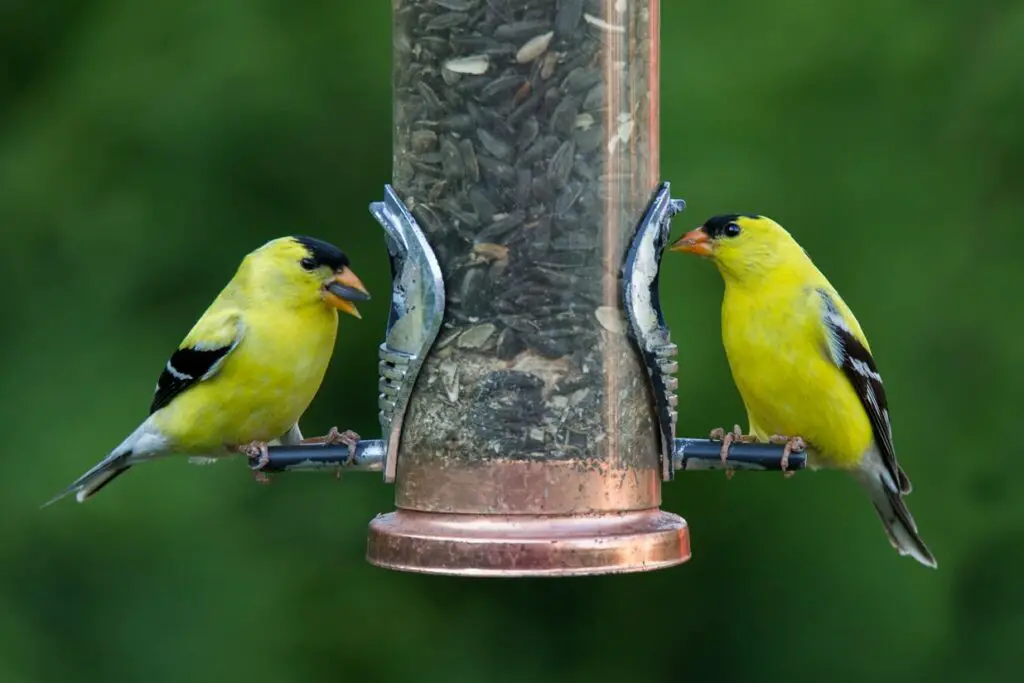
- Scientific Name: Spinus Tristis
- Size: 4.3 to 5.1 inches
- Weight: 0.4 to 0.7 ounces
- Wingspan: 7.5 to 8.7 inches
As their name may suggest, the American goldfinch can be found throughout the United States as well as along the east coast of Mexico (and southern Canada during breeding season). With the thistle and aster seeds as main parts of their diets, American goldfinches can be found in fields where thistles and aster are common.
A female American goldfinch will build the solid, cup-shaped nest by herself and place it less than thirty feet up in weeds, shrubs, or small trees. Then, she will have two to seven eggs twice per year.
American goldfinches molt their feathers twice per year (at the end of winter and summer), and their bright yellow plumage is often regarded as a sign of warm weather to come.
2. Cape May Warbler

- Scientific Name: Setophaga Tigrina
- Size: 4.7 to 5.1 inches
- Weight: 0.4 to 0.5 ounces
- Wingspan: 7.9 to 8.7 inches
Mostly native to Central America, the Cape May warbler will migrate through the eastern part of the United States to reach the southeastern part of Canada for breeding. It is common to see Cape May warblers in forests or shrubby areas both in and out of breeding season.
For safety purposes, Cape May warblers build their cup-shaped nests at the top of fir or spruce trees (thirty-five to sixty feet up). The female will then lay six to seven eggs in her annual brood.
Because Cape May warblers consume nectar as a regular part of their diet, their tongues are uniquely curled and semi-tubular amongst the warbler species.
3. Common Yellowthroat

- Scientific Name: Geothlypis Trichas
- Size: 4.3 to 5.1 inches
- Weight: 0.3 ounces
- Wingspan: 5.9 to 7.5 inches
Common yellowthroats can be seen year-round in the southeast United States, Mexico, and Central America but migrate as far north as the Yukon Territory province of Canada to breed. When not breeding, common yellowthroats prefer dense, low vegetation like that found in open fields, marshes, and forest floors.
The female common yellowthroat of a mated pair will build an open cup nest that she places low to the ground in tall grass, small shrubs, or even among cattails near marshes. Common yellowthroats have two broods per year, each consisting of three to five eggs.
While a male common yellowthroat only takes one female into his breeding territory during the mating season, a female’s call may attract other males that she will mate with behind the male’s back.
4. Eurasian Golden Oriole
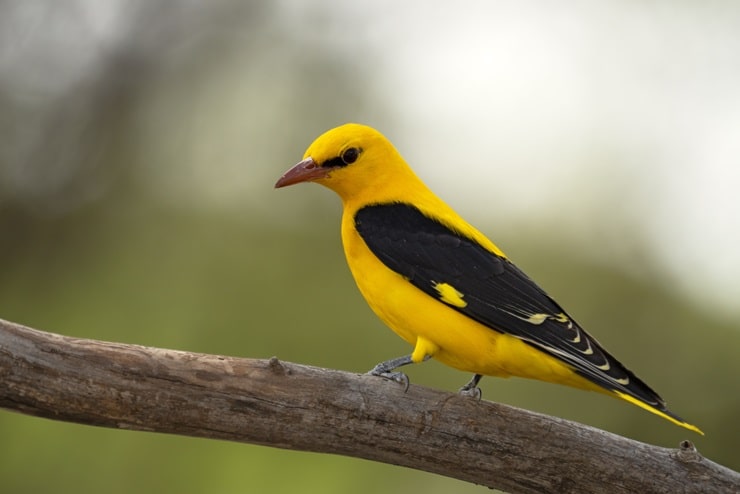
- Scientific Name: Oriolus Oriolus
- Size: 9.4 inches
- Weight: 2.8 ounces
- Wingspan: 17 to 18.5 inches
As the name might suggest, Eurasian golden orioles do spend their summers breeding in most of Europe and spread as far east as China. They winter in southern and central Africa. Eurasian golden orioles are rarely seen in habitats without trees.
The Eurasian golden oriole builds a cup-shaped nest that is then suspended under the fork of smaller branches in a tree or shrub. The female will then have three to five eggs in her annual brood.
While normal communication between Eurasian golden orioles is a sweet whistling song, they produce harsh, screeching noises to alert other birds of danger.
5. Evening Grosbeak

- Scientific Name: Coccothraustes Vespertinus
- Size: 6.3 to 7.1 inches
- Weight: 1.9 to 2.6 ounces
- Wingspan: 11.8 to 14.2 inches
Evening grosbeaks tend to like colder climates and are most commonly seen in the southern parts of Canada but do make appearances in the majority of the United States. They tend to prefer forests at higher altitudes that include both conifer and deciduous trees, especially those that will keep them fed all winter.
The loose cup nest is often built by the female of the evening grosbeak species, and it gets built anywhere from ten to one hundred feet up in a tree on a horizontal branch or a vertical fork in the tree. The female will have one to two broods per year with two to five eggs in each.
Due to larger beaks, the evening grosbeak can split apart seeds that are too difficult for other birds to manage, but they often inadvertently leave scraps behind for smaller birds.
6. Saffron Finch
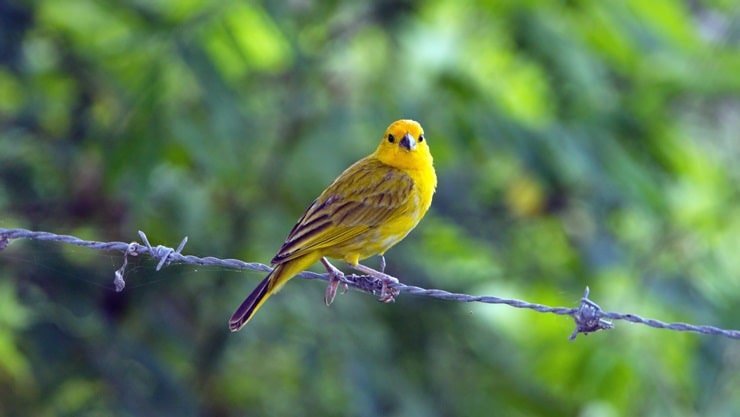
- Scientific Name: Sicalis Flaveola
- Size: 5.2 to 5.5 inches
- Weight: 0.7 ounces
- Wingspan: 8.1 to 9.2 inches
Native to South America, the saffron finch is often seen in countries that lie outside of the Amazon Basin (like Columbia, Bolivia, Uruguay, and Paraguay) and has been introduced to Hawai’i, Panama, and Puerto Rico. Saffron finches prefer semi-open to open lowlands.
Preferring some privacy during the nesting period, saffron finches choose to nest in cavities like abandoned nests, in bamboo branches, or under roofs. The female saffron finch will then have three to six eggs in her annual brood.
Though male saffron finches are polygamous during the mating season, they are very territorial and have been known to fight when enclosed with another male.
7. Western Tanager
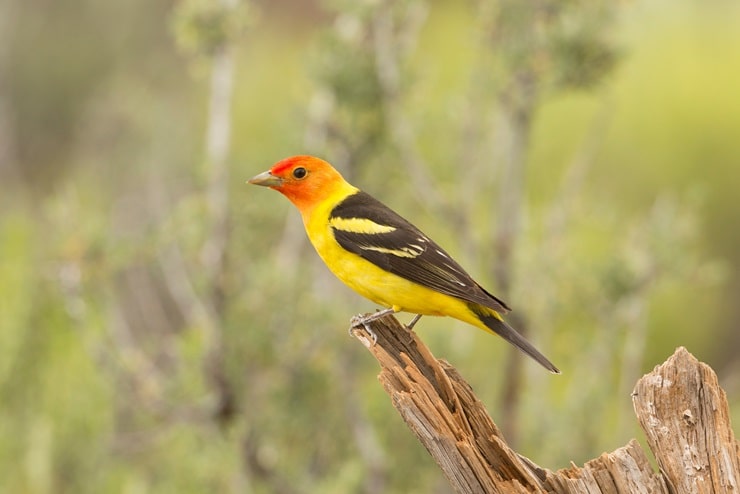
- Scientific Name: Piranga Ludoviciana
- Size: 6.3 to 7.5 inches
- Weight: 0.8 to 1.3 ounces
- Wingspan: 11.5 inches
As their name might suggest, western tanagers are commonly seen on the western sides of both the United States and Canada during the breeding season but are native to central Mexico. Though they aren’t particular about which conifer trees they choose, western tanagers are often seen in forests and woodlands.
Their habitat preference is also their nesting preference, and the female western tanager will place a shallow cup nest around fifteen to sixty-five feet up in a conifer tree. Then, the female will have three to five eggs in her once-per-year brood.
The western tanager breeds as far north as the northwest territories of Canada, which is the farthest north of any species of tanager.
8. White-Eyed Vireo
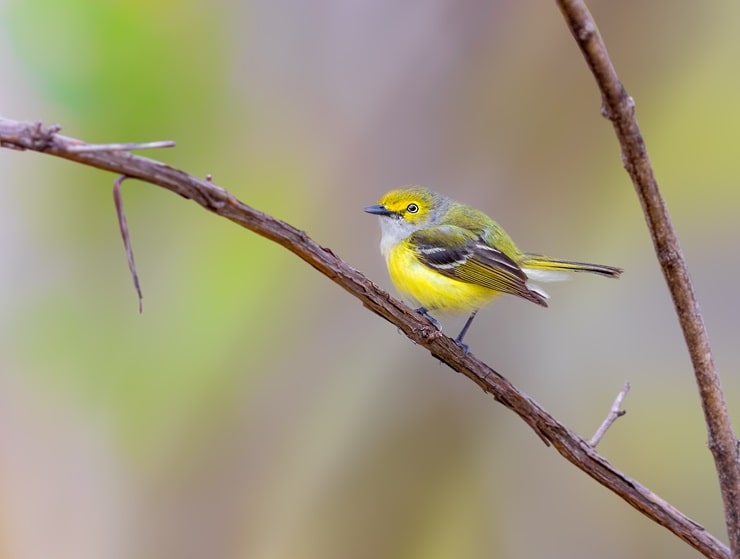
- Scientific Name: Vireo Griseus
- Size: 4.3 to 5.1 inches
- Weight: 0.3 to 0.5 ounces
- Wingspan: 6.7 inches
The primary population of white-eyed vireos is located in the southeastern United States, the Caribbean, and the eastern coast of Mexico but they do breed in the central and midwestern portions of the United States. They like habitats with plenty of overgrowth like forest edges, deciduous scrubs, and thickets next to streams.
Both of the sexes of a breeding pair help build the deep cup nest that usually hangs from a branch no more than twenty-five feet above the ground in a shrub or tree. The female white-eyed vireo will have three to five eggs and if she is in the north she’ll have one brood but two broods if she’s in the south.
While both sexes of white-eyed vireo sing when they are wintering, only the male will sing when they are in breeding grounds.
9. Yellow-Breasted Chat
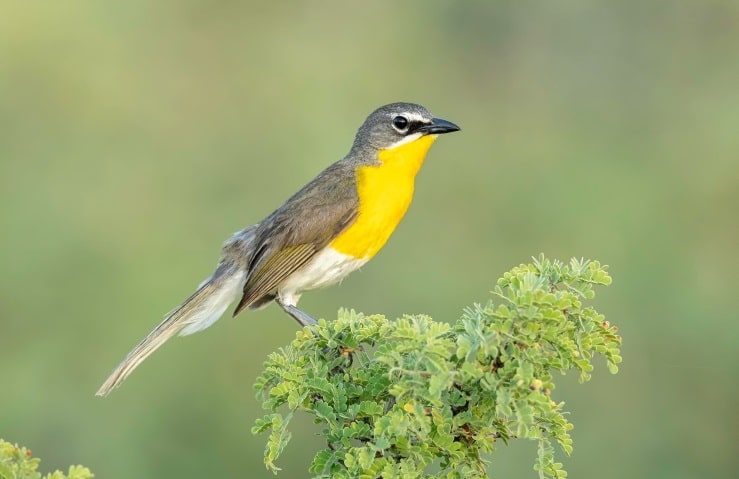
- Scientific Name: Icteria Virens
- Size: 7.1 inches
- Weight: 0.8 to 1.1 ounces
- Wingspan: 9.8 inches
The yellow-breasted chat is native to Central America as well as southern and coastal portions of Mexico. They venture into northern Mexico and most of the United States to breed. Yellow-breasted chats like thick areas of growth including brambles and shrubs that grow on stream banks.
It can be difficult to find a yellow-breasted chat’s open cup nest because they tend to place it between one and eight feet above the ground in a thick bush. The female will typically have two broods per year with three to six eggs in each.
Yellow-breasted chats often fall prey to the parasitic brown-headed cowbird, who will lay their eggs in the yellow-breasted chats’ nests. Some will abandon their birds because of this or raise the brow-headed cowbird as their own.
10. Yellow Warbler
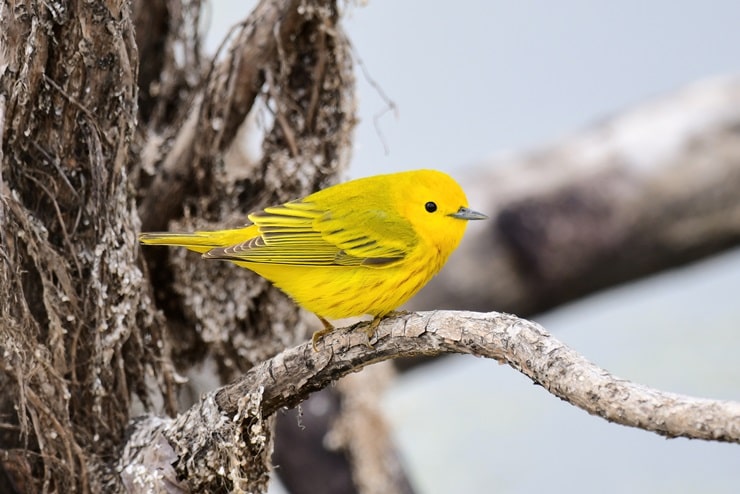
- Scientific Name: Setophaga Petechia
- Size: 4.7 to 5.1 inches
- Weight: 0.3 to 0.4 ounces
- Wingspan: 6.3 to 7.9 inches
The yellow warbler is native to the northern portion of South America and throughout Central America but breeds as far north as the Yukon Territory in Canada. Preferential to water, the yellow warbler likes forests and thickets beside streams or wetlands.
A female yellow warbler is in charge of building the compact, open-cup nest that is placed two to sixty feet up on a vertical fork in a branch of a tree or shrub. Then, the female will have three to six eggs in each of the two broods she has per year.
Similar to the yellow-breasted chats, yellow warblers’ nests are also parasitized by brown-headed cowbirds. However, yellow warblers will simply build a new nest over the parasitized one, which sometimes results in six-tiered nests.
Other Colored Birds:
Purple Birds
Blue Birds
Black Birds
Orange Birds
